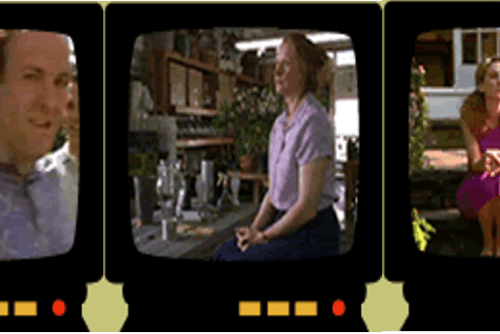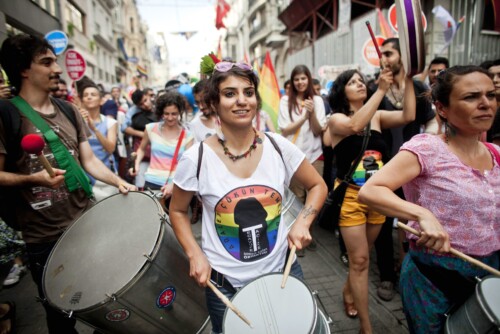In its most serious form, homophobia and transphobia can ultimately affect the outcome of criminal prosecutions and may even encourage the imposition of death sentences for queer defendants deemed guilty of capital crimes.1 There are no explicit restrictions on what personal information can be introduced about a defendant’s sexuality or gender expression, and the rules against statements that might inflame a jury are not necessarily enforced when the defendant is queer.2 Ambitious prosecutors are often free to play to stereotypical beliefs about queer people, and have reason to single out gender non-conforming defendants when deciding which cases might convince a jury to opt for execution.3 Appeals to anti-queer and anti-trans animus have a notable impact on juries.4 Moreover, nowhere is the identity of a lesbian more integral to her treatment than when she is facing punishment for a capital crime. Lesbians are disproportionately represented among death row inmates. A staggering 40 percent of women on death row are lesbians or have had sexual orientation used as a factor against them in criminal sentencing.5 In the case of Wanda Jean Allen, a lesbian defendant executed for the capital murder of her lover, the trial court admitted evidence that Allen was the “man” in the lesbian relationship. This evidence was apparently “used to show that [Allen] was the aggressive person in the relationship, while [her lover] was more passive.” The appeals court reasoned that the evidence would “help the jury understand why each party acted the way she did both during events leading up to the shooting and the shooting itself.”6)
Although homophobia and transphobia have been used in the judicial system as aggravating factors in the trials of queer defendants, mainstream gay rights groups have not typically demonstrated support for capital defendants. Law professor and criminal defense attorney Abbe Smith analyzes the case of Aileen Wournos, dubbed by the media as the first “female serial killer.”7 Wournos, a truck-stop prostitute (and also a victim of extraordinary sexual abuse throughout her life) was executed in 1992 for the murders of seven men in Florida. Despite her claims of self-defense,8 Wournos was found guilty by a jury in one and one-half hours and sentenced to die in one hour and forty-eight minutes.9 Wournos was also a lesbian, and Smith notes that mainstream feminists were not eager to be associated with a “man-hating” lesbian prostitute who killed seven men. Wournos presented the worst possible image of a lesbian killer. As one commentator declared, “her crimes were male (italics mine) in their commission: predatory, cold-blooded, premeditated, and malicious.”10 Media coverage focusing on Wournos’s supposed predatory proclivities served to minimize the effects of psychological trauma she experienced due to the constant sexual violence that had been perpetrated against her.
The larger point in Smith’s analysis is that, in the rush to punish heinous crimes, we often fail to examine the very direct link between victimhood and criminal behavior. Smith concludes that:
Victims and perpetrators . . . are often the same people. Those who claim to care about victims of child abuse, sexual assault, and domestic violence and who abandon them when they repeat the behavior by acting out against others fail to make these critical connections. Further, it is hypocritical to embrace people when they are ‘victims’ and blindly declare them to be ‘predators’ and ‘criminals’ when they become ‘perpetrators.’ Yet, sadly, this is what many prosecutors do. Even more disappointing is when thoughtful critics of the current system, including feminists and advocates for victims—those whose life work is devoted to social reform—do this.11
The critique that Smith offers represents an example of a lost opportunity to draw attention to systemic bias in the criminal justice system. Though these high profile events often provide unsympathetic facts, it is important to demonstrate the trickle down effect of bias on the lives of queer people who experience daily injustices when confronting the justice system. These cases also remind us that caution should be exercised when relying solely on courts and law enforcement to address intractable social problems, such as domestic violence.
- See Victor L. Streib, Death Penalty for Lesbians, 1 NAT’L L.J. SEX. ORIENTATION L. 105 (1994) http://www.ibiblio.org/gaylaw/issue1/streib.html (noting lesbians may be “defeminized” by prosecutors by using their sexual orientation and then dehumanized for the crime, leaving a jury with a gender-neutral monster deserving of little or no human compassion) [hereinafter Streib, Death Penalty]; see also Richard Goldstein, “Queer on Death Row: In Murder Cases Being Gay can Seal a Defendant’s Fate,” Village Voice, March 13, 2001, at 38 http://www.villagevoice.com/2001-03-13/news/queer-on-death-row/, [hereinafter Goldstein, Queer on Death Row]. [↩]
- Streib, Death Penalty, supra note 62, at 109-110. [↩]
- Goldstein, Queer on Death Row, supra note 62, at 38; Streib, Death Penalty, supra note 62, at 110-111; see also Tracy Baim, “Death Penalty Shocker,” Windy City Times, January 15, 2003 (noting that the prosecution biased the jury with homophobia by repeatedly used Mata’s lesbianism as her motive for killing a man, calling her a “Hard Core Lesbian” and “Man-hating Lesbian”) http://www.windycitymediagroup.com. [↩]
- DecisionQuest/National Law Journal: 2000 Annual Juror Outlook (2000) http://dqadmin.com/2000%20AJOS_web1.pdf (finding that twelve percent of jurors said they could not be fair to a lesbian or homosexual party in a case). [↩]
- Goldstein, Queer on Death Row, supra note 62, at 38. See also American Civil Liberties Union and American Friends Service Committee, The Forgotten Population: A Look at Death Row in the United States Through the Experiences of Women (2004): 8 (noting that in several cases, prosecutors appeared to use the woman’s sexual orientation to prejudice the jury against her, and that bias may have made a difference in the outcome). [↩]
- Michael B. Shortnacy, Guilty and Gay, A Recipe for Execution in American Courtrooms: Sexual Orientation as a Tool for Prosecutorial Misconduct in Death Penalty Cases, 51 AM. U. L. REV. (2001): 309, 301-344 (Noting that the court concluded that, given the circumstances of the crime, the probative value of the character evidence “was not substantially outweighed by its prejudicial effect.” [↩]
- Abbe Smith, The “Monster” in All of Us: When Victims Become Perpetrators, 38 SUFFOLK U. L. REV. (2005): 367, 378. Wournos was the subject of the major motion picture, Monster (2003). Actress Charlize Theron received numerous awards, including the Academy Award, for her portrayal of Wournos. [↩]
- Id. at 379. “She was also diagnosed by both defense and state mental health experts as suffering from an emotional and/or mental disturbance at the time of the offenses and having an impaired ability to conform her conduct to the requirements of law. Both of these, as well as her history of physical and sexual abuse and alcoholism, could have been considered mitigating circumstances for sentencing purposes.” [↩]
- Id. at 383. Smith notes that by comparison, the jury for Ted Bundy, tried in Florida for having killed more than twenty women, took seven hours to find him guilty and seven and a half more hours to sentence him to death. [↩]
- Id. at 382. [↩]
- Id. at 394. In her critique pointing out the lack of response to the case, Smith asks, “Why did feminists, battered women’s advocates, or sexual assault victims rights advocates not get involved in the Wournos case? Why did they not help her to obtain counsel, raise money for expert testimony, visit her in jail, attend her trial, and, especially, protest her execution? Why did they not at least write an op-ed piece?” [↩]




